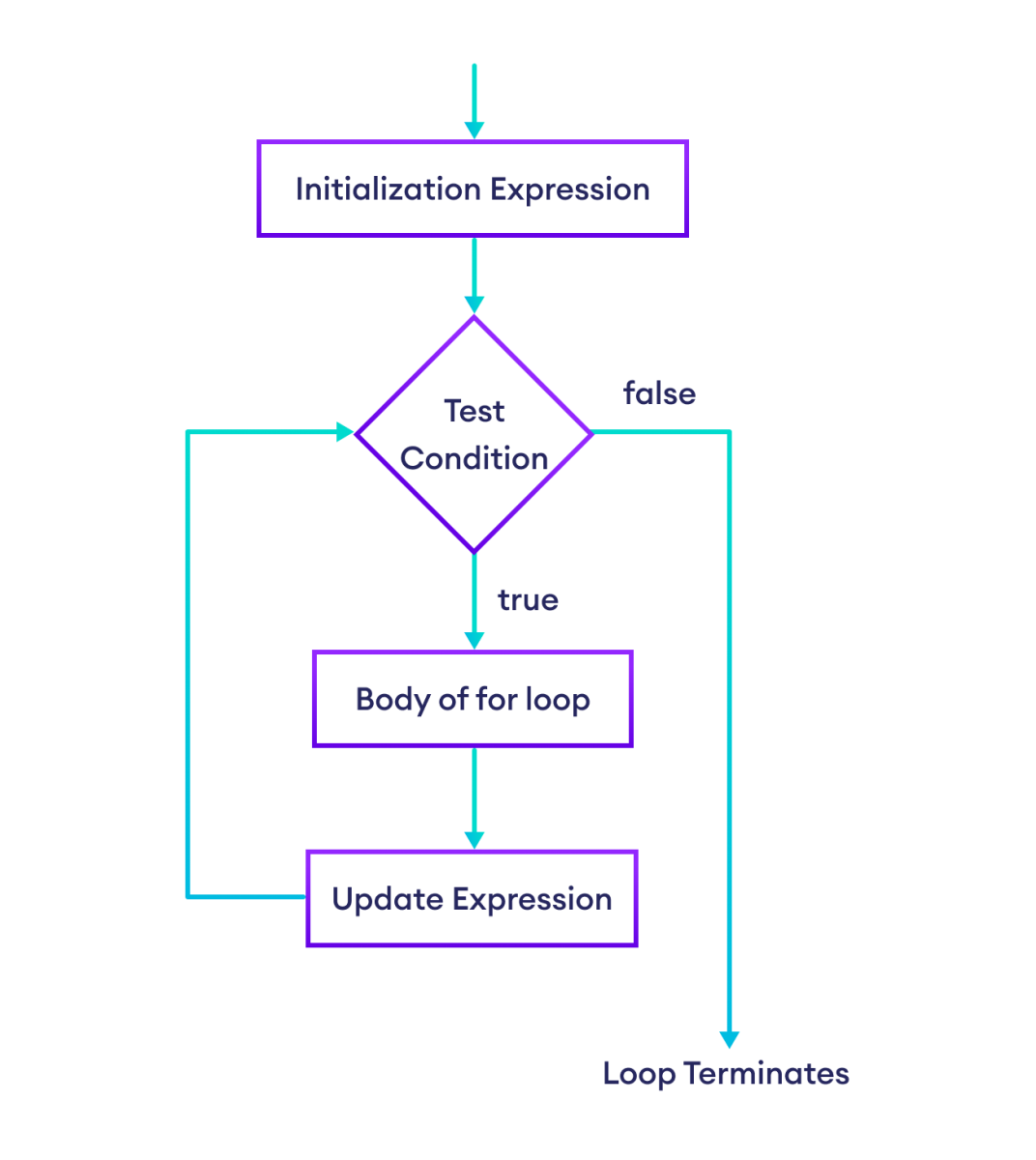In JavaScript, the for loop is used for iterating over a block of code a certain number of times, or to iterate over the elements of an array.
Here's a quick example of the for loop. You can read the rest of the tutorial for more details.
Example
for (let i = 0; i < 3; i++) {
console.log("Hello, world!");
}
// Output:
// Hello, world!
// Hello, world!
// Hello, world!
In this example, we used the for loop to print "Hello, world!" three times to the console.
JavaScript for loop Syntax
The syntax of the for loop is:
for (initialExpression; condition; updateExpression) {
// for loop body
}
Here,
initialExpression- Initializes a counter variable.condition- The condition to be evaluated. Iftrue, the body of theforloop is executed.updateExpression- Updates the value ofinitialExpression.
Once an iteration of the loop is completed, the condition is evaluated again. The process continues until the condition is false.
To learn more about the condition, visit JavaScript Comparison and Logical Operators.
Flowchart of JavaScript for Loop

Example 1: Print Numbers From 1 to 5
for (let i = 1; i < 6; i++) {
console.log(i);
}
Output
1 2 3 4 5
In this example, we have printed numbers from 1 to 5 using a for loop.
Here is how this program works:
| Iteration | Variable | Condition: i < 6 | Action |
|---|---|---|---|
| 1st | i = 1 |
true |
1 is printed. i is increased to 2. |
| 2nd | i = 2 |
true |
2 is printed. i is increased to 3. |
| 3rd | i = 3 |
true |
3 is printed. i is increased to 4. |
| 4th | i = 4 |
true |
4 is printed. i is increased to 5. |
| 5th | i = 5 |
true |
5 is printed. i is increased to 6. |
| 6th | i = 6 |
false |
The loop is terminated. |
Example 2: Display Sum of n Natural Numbers
// program to display the sum of natural numbers
let sum = 0;
const n = 100
// loop from i = 1 to i = n
// in each iteration, i is increased by 1
for (let i = 1; i <= n; i++) {
sum += i; // sum = sum + i
}
console.log(`sum: ${sum}`);
// Output: sum: 5050
Initially, the value of sum is 0, while n has a constant value of 100.
Then, we iterate a for loop from i = 1 to n. In each iteration,
- i is added to sum.
- Then, the value of i is increased by 1.
When i becomes 101, the test condition becomes false and sum will be equal to 0 + 1 + 2 + ... + 100.
Iterate Through an Array
A for loop can also be used to iterate over elements of an array. For example,
const fruits = ["apple", "banana", "cherry"];
for (let i = 0; i < fruits.length; i++) {
console.log(fruits[i]);
}
Output
apple banana cherry
This loop iterates through the fruits array and prints each element to the console.
More on JavaScript for loop
A for loop can also have another for loop inside it. For each cycle of the outer loop, the inner loop completes its entire sequence of iterations. For example,
// outer loop
for (let i = 0; i < 3; i++) {
// inner loop
for (let j = 0; j < 2; j++) {
console.log(`i = ${i}, j = ${j}`);
}
}
Output
i = 0, j = 0 i = 0, j = 1 i = 1, j = 0 i = 1, j = 1 i = 2, j = 0 i = 2, j = 1
Here,
- Outer Loop - Runs from
i = 0 to 2. - Inner Loop - Runs from
j = 0 to 1.
In each iteration of the outer loop, the inner loop runs from j = 0 to 1.
In JavaScript, we can create an infinite for loop by setting a condition that always evaluates to true. For example,
for (let i = 0; true; i++) {
console.log("This loop will run forever!");
}
Output
This loop will run forever! This loop will run forever! This loop will run forever! …
In this example, the condition in the for loop is explicitly set to true.
Since this condition never changes and always evaluates to true, the loop will continue indefinitely (until the memory is full).
Note: Creating an infinite loop is something that we should generally avoid, as it will consume all available resources to execute the loop endlessly.
We can omit any part of the for loop declaration and include it in a different part of the code.
Let's look at an example.
// initialization outside the loop
let i = 0;
// omit initialization and update statements
for (; i < 3; ) {
console.log(`i is ${i}`);
// increment inside the loop body
i++;
}
Output
i is 0 i is 1 i is 2
Here, we have initialized i before the loop, which iterates as long as i is less than 3.
Notice that i is incremented within the loop body, which allows us to skip the update statement inside the parentheses () of the for loop.
In other words, for (; i < 3; ) indicates omitted initialization and update expression, focusing only on the condition.
Also Read: